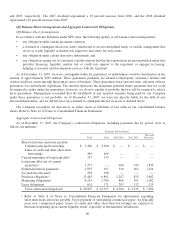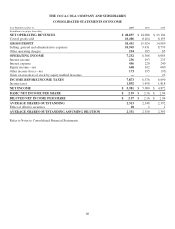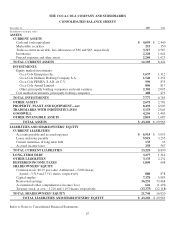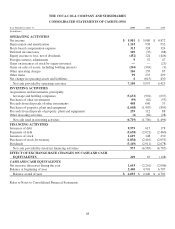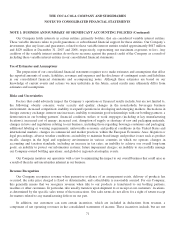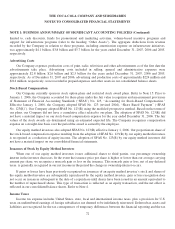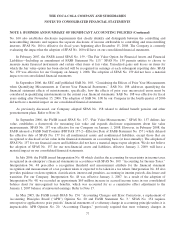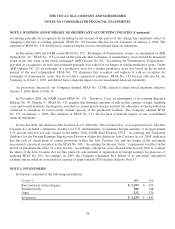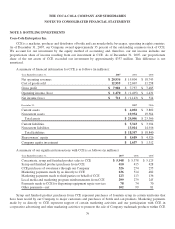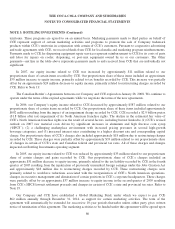Coca Cola 2007 Annual Report Download - page 72
Download and view the complete annual report
Please find page 72 of the 2007 Coca Cola annual report below. You can navigate through the pages in the report by either clicking on the pages listed below, or by using the keyword search tool below to find specific information within the annual report.THE COCA-COLA COMPANY AND SUBSIDIARIES
NOTES TO CONSOLIDATED FINANCIAL STATEMENTS
NOTE 1: BUSINESS AND SUMMARY OF SIGNIFICANT ACCOUNTING POLICIES
Description of Business
The Coca-Cola Company is predominantly a manufacturer, distributor and marketer of nonalcoholic beverage
concentrates and syrups. We also manufacture, distribute and market finished beverages. In these notes, the terms
“Company,” “we,” “us” or “our” mean The Coca-Cola Company and all subsidiaries included in the consolidated financial
statements. We primarily sell concentrates and syrups, as well as finished beverages, to bottling and canning operations,
distributors, fountain wholesalers and fountain retailers. Our Company owns or licenses more than 450 brands, including
Coca-Cola, Diet Coke, Fanta and Sprite, and a variety of diet and light beverages, waters, enhanced waters, juices and juice
drinks, teas, coffees, and energy and sports drinks. Additionally, we have ownership interests in numerous beverage joint
ventures, bottling and canning operations. Significant markets for our products exist in all the world’s geographic regions.
Basis of Presentation and Consolidation
Our consolidated financial statements are prepared in accordance with accounting principles generally accepted in
the United States. Our Company consolidates all entities that we control by ownership of a majority voting interest as
well as variable interest entities for which our Company is the primary beneficiary. Refer to the heading “Variable
Interest Entities,” below, for a discussion of variable interest entities.
We use the equity method to account for our investments for which we have the ability to exercise significant
influence over operating and financial policies. Consolidated net income includes our Company’s proportionate share
of the net income or net loss of these companies.
We use the cost method to account for our investments in companies that we do not control and for which we do
not have the ability to exercise significant influence over operating and financial policies. In accordance with the cost
method, these investments are recorded at cost or fair value, as appropriate.
We eliminate from our financial results all significant intercompany transactions, including the intercompany
transactions with variable interest entities and the intercompany portion of transactions with equity method investees.
Certain amounts in the prior years’ consolidated financial statements and notes have been revised to conform to
the current-year presentation.
Variable Interest Entities
Financial Accounting Standards Board (“FASB”) Interpretation No. 46 (revised December 2003), “Consolidation
of Variable Interest Entities” (“Interpretation No. 46(R)”) addresses the consolidation of business enterprises to which
the usual condition (ownership of a majority voting interest) of consolidation does not apply. Interpretation No. 46(R)
focuses on controlling financial interests that may be achieved through arrangements that do not involve voting
interests. It concludes that in the absence of clear control through voting interests, a company’s exposure (variable
interest) to the economic risks and potential rewards from the variable interest entity’s assets and activities is the best
evidence of control. If an enterprise holds a majority of the variable interests of an entity, it would be considered the
primary beneficiary. Upon consolidation, the primary beneficiary is generally required to include assets, liabilities and
noncontrolling interests at fair value and subsequently account for the variable interest as if it were consolidated based
on majority voting interest.
Our consolidated balance sheets include the assets and liabilities of the following:
• all entities in which the Company has ownership of a majority of voting interests; and
• all variable interest entities for which we are the primary beneficiary.
70


